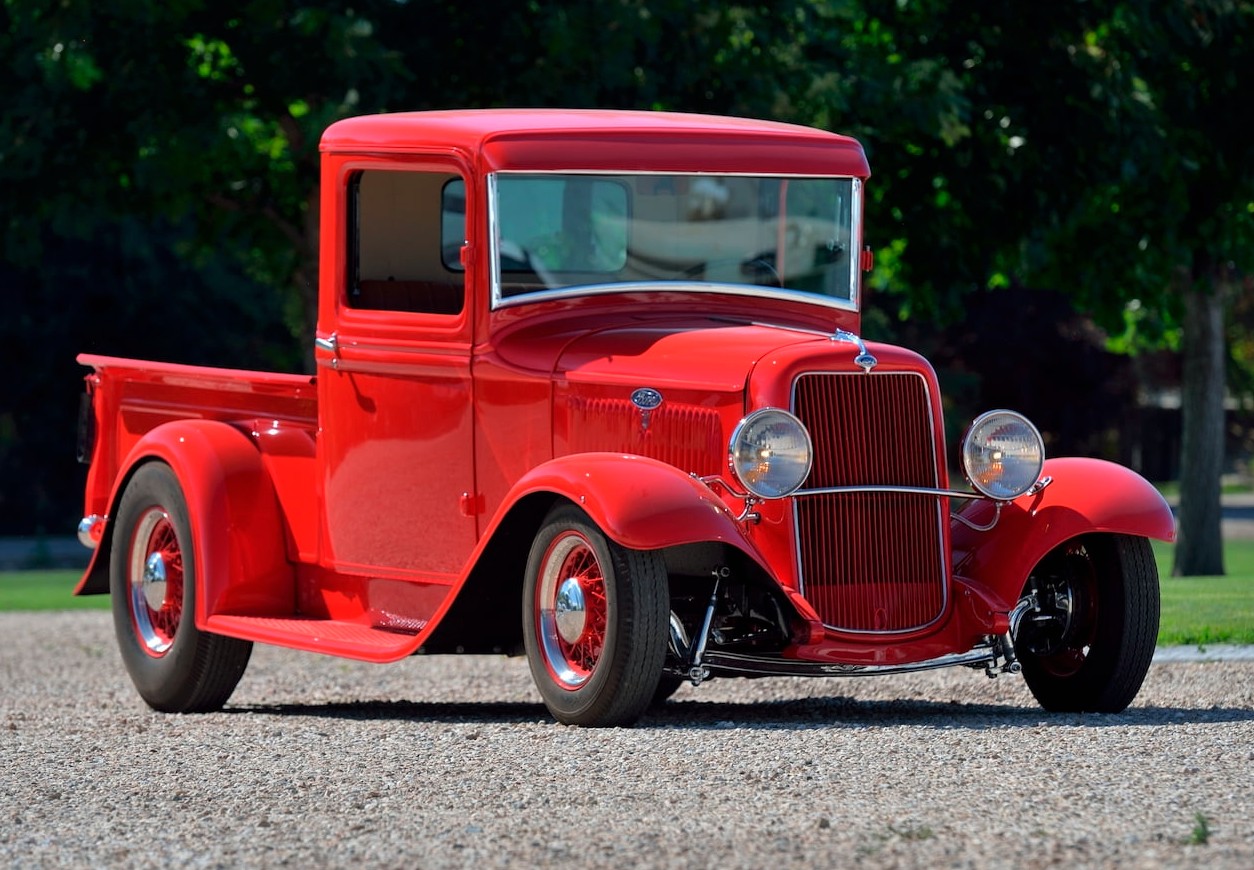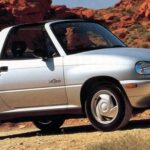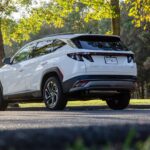The Ford Motor Company’s journey into truck manufacturing began in 1917, marking the inception of a legacy that would redefine the American automotive landscape. Their initial offering, the Ford Model TT, was a robust adaptation of the Model T passenger car, featuring a stronger frame and axle to handle a one-ton payload. This foundational model paved the way for Ford to become a dominant force in the world of pickup trucks, consistently pushing boundaries with iconic series like the F-1, F-100, and the ever-popular F-150. Join us as we delve into the captivating history of Ford trucks, tracing their evolution from these pioneering models to the modern marvels of the F-Series.
1928-1931: The Model AA Era
The Ford Model AA emerged in 1928 as the successor to the Model TT, continuing Ford’s commitment to robust and reliable commercial vehicles. This era represents a crucial step in Ford truck history, setting the stage for future innovations and designs.
A beautifully restored 1928 Ford Model AA truck, showcasing the classic design and robust build that defined early Ford commercial vehicles.
In 1932, Ford transitioned to the Model BB truck, mirroring the passenger car line’s shift from the Model A to the Model B. A significant advancement during this period was the introduction of the flathead V8 engine as an option for the Model BB. While the TT and AA models were limited to four-cylinder engines, the Model BB offered the choice of the standard four-cylinder or Ford’s revolutionary flathead V8. This engine innovation would have a profound impact on automotive culture.
Front profile of a meticulously maintained 1934 Ford Model BB pickup truck, highlighting its iconic grille and robust design from the early Ford truck lineage.
The Ford flathead V8 engine, with its lightweight design and considerable power potential, became a cornerstone of early hot rod culture and automotive enthusiasm in the United States throughout the 1930s and beyond. Its compact size and inherent tunability made it a favorite among mechanics and enthusiasts who sought to enhance performance. This era saw the rise of aftermarket parts companies like Edelbrock, Hilborn, Winfield, and Stromberg, catering to a growing demand for performance upgrades. These advancements allowed both amateur and professional mechanics to customize and enhance their vehicles, building high-performance cars and trucks from readily available parts. Classic Industries emerged during this vibrant period, recognizing the need for restoration and performance parts for Ford trucks, ensuring that enthusiasts could maintain and upgrade their vehicles from the Model BB era through the latest F-150 models up to 2017.
1932-1947: Car-Based Designs and Wartime Interruption
From 1932 to 1939, Ford trucks adopted car-based designs, each year featuring distinct truck grilles that differed from the concurrent Ford passenger car models. However, in 1940 and 1941, Ford trucks began to share grilles and front fenders with their passenger car counterparts, reflecting a shift towards more streamlined production and design commonality.
A fully restored 1941 Ford pickup truck, painted in its original Ford Blue with black fenders, powered by a classic 221-cubic inch flathead V8 engine.
The onset of World War II led to a halt in civilian vehicle production from 1942 to 1945 as Ford, along with other American manufacturers, dedicated their resources to producing vehicles and machinery for the war effort. After the war, Ford gradually resumed civilian production, with the 1946 and 1947 truck models remaining largely unchanged from their 1941 predecessors, bridging the pre-war and post-war automotive eras.
1948-1952: The First Generation F-Series – Bonus-Built Era
1948 marked a pivotal year with the introduction of the first-generation F-Series trucks, also known as the Bonus-Built trucks. These models replaced the pre-war car-based designs and represented a significant step forward in truck engineering and design.
A beautifully customized 1948 Ford F-1, showcasing the iconic 5-bar grille and recessed headlamps of the first-generation F-Series, enhanced with modern resto-mod elements.
The first-generation F-Series offered a wide range of models, spanning eight weight classifications and various body styles including pickup, cab-over engine (COE), panel truck, conventional truck, and school bus chassis. The model designations ranged from the light-duty F-1 to the heavy-duty F-8, establishing a naming convention that would become a hallmark of Ford trucks. The 1952 Ford F-1, an all-steel model, exemplified the robust construction of this era. Often powered by a modified Ford 351 Windsor V8 engine and featuring custom wheels, these trucks blended classic design with emerging street rod styling.
1953-1956: Second Generation F-Series – Embracing Modernization
The second generation F-Series, introduced in 1953, brought about significant improvements focusing on chassis updates, increased cab dimensions, and enhanced engine options. This generation marked the transition to the iconic F-100, F-250, and F-350 designations that remain central to the Ford truck lineup today.
A meticulously restored 1953 Ford F-100, finished in Glacier Blue, highlighting the second generation’s updated design and classic appeal.
The F-1 half-ton became the F-100, while the F-2 and F-3 three-quarter-ton models evolved into the F-250. The one-ton F-4 was renamed the F-350. This three-digit naming convention after the “F” dash became a permanent fixture for Ford trucks, simplifying model identification and reflecting payload capacity. While the 1953 to 1956 F-100 models shared core components like hoods, doors, and cabs, the 1956 model year introduced notable refinements. The 1956 F-100 featured a redesigned dashboard, an optional panoramic rear window, different doors, optional seat belts, and a wraparound windshield. These changes expanded the greenhouse area, providing a more open interior feel and improved driver visibility.
The engine compartment of a custom 1956 Ford F-100, showcasing a powerful Ford 351 Windsor V8 engine with performance upgrades and vibrant orange accents.
Customized examples, like the 1956 F-100 with a House of Kolor Ultra Orange Pearl finish and a Ford 351 Windsor V8 engine enhanced by Granatelli Performance, demonstrate the enduring appeal and customization potential of these second-generation trucks.
1957-1960: Third Generation F-Series – Streamlined Design
The third generation F-Series (1957-1960) brought a smoother, more integrated design aesthetic. Integrated front fenders and the introduction of the Styleside bed created a seamless look from front to rear, marking a departure from the earlier, more utilitarian designs.
A striking 1957 Ford F-100 pickup truck, presented in its third-generation design with integrated front fenders and stylish wide whitewall tires.
During this generation, Ford also introduced the tilt-forward cab C-Series, replacing the previous cab-over F-Series models. Another significant development was the commencement of in-house production of four-wheel-drive pickups, expanding the versatility and capability of Ford trucks.
1961-1966: Fourth Generation F-Series – Unibody Experiment and Twin I-Beam Suspension
The fourth generation (1961-1966) was marked by significant changes in both design and engineering. Ford experimented with a unibody design from 1961 to 1963, integrating the cab and bed into a single flowing structure. However, this design proved unpopular and was discontinued after the 1963 model year, with Ford reverting to the traditional separate cab and bed configuration.
A meticulously restored 1966 Ford F-100 pickup, featuring a powerful Thunderbird 427 CI V-8 engine and Wilwood disc brakes, showcasing the fourth generation’s design and performance enhancements.
A major mid-year redesign in 1965 introduced the revolutionary “Twin I-Beam” front suspension system. This new chassis and suspension setup significantly improved ride quality and durability, becoming a Ford truck hallmark that continued on F-150 4×2 models until 1996 and F-250/350 4×2 models until 2016. The Ranger nameplate also debuted during this generation, initially as a high-level styling package, foreshadowing its later use as a distinct Ford truck model.
1967-1972: Fifth Generation F-Series – Enhanced Comfort and Styling
The fifth generation (1967-1972) Ford trucks focused on enhanced comfort, expanded engine choices, and more refined styling. Trim levels became plusher, and the cab’s greenhouse glass area increased, improving visibility and interior spaciousness. The exterior dimensions also grew slightly, contributing to a more substantial presence.
A stunning 1967 Ford F-100 painted in Candy Apple Red, equipped with a 302 CI engine, automatic transmission, and Vintage Air HVAC system, exemplifying the fifth generation’s focus on style and comfort.
1973-1979: Sixth Generation F-Series – The Birth of the F-150
The sixth generation (1973-1979) Ford trucks were characterized by a double-wall bed, front disc brakes, increased use of galvanized steel for rust resistance, and larger cabin dimensions. 1975 marked a significant milestone with the introduction of the Ford F-150, positioned between the F-100 and F-250, which would quickly become a cornerstone of the Ford truck lineup.
A rugged 1976 Ford F-150 4×4 pickup, equipped with a 360 CI V8 engine, automatic transmission, power steering, and alloy wheels, representing the birth of the iconic F-150.
In 1978, higher trim models like the Ranger and Lariat adopted square headlamps, replacing the round lights. By 1979, rectangular headlamps became standard across the Ford truck range, modernizing the front-end appearance.
1980-1986: Seventh Generation F-Series – Aerodynamic and Fuel-Efficient Design
The seventh generation (1980-1986) brought a complete redesign of the F-Series, featuring a new chassis and body style. The design emphasized squared-off body lines and rectangular headlamps but also incorporated improved aerodynamics to enhance fuel efficiency, reflecting the changing automotive landscape of the 1980s.
A well-preserved 1986 Ford F-150 XLT Lariat, featuring a fuel-injected 5.0L V8 engine and 4-speed automatic transmission, highlighting the seventh generation’s focus on fuel efficiency and modern features.
Engine options during this generation included a 3.8L V6 and 4.2L V8 for a limited period. A pivotal advancement was the introduction of fuel injection for the 5.0L V8 in 1986, an industry-leading move for American trucks, enhancing performance and efficiency.
1987-1991: Eighth Generation F-Series – Fuel Injection and Interior Updates
The eighth generation (1987-1991) F-Series retained the cab from the previous generation but featured a redesigned front end and interior. Ford continued its transition to fuel injection, converting the 4.9L inline-6 to fuel injection in 1987. The F-150 became the first American truck line to eliminate carbureted engine options entirely, embracing fuel injection across the range. The Super Duty designation was introduced in 1987, initially for heavy-duty chassis cab models, setting the stage for its future expansion.
1992-1997: Ninth Generation F-Series – Refined Styling and SVT Lightning
The ninth generation (1992-1997) F-Series brought further refinements, utilizing the 1980-1986 cab and chassis but with significant updates to the hood, headlamps, grille, and interior. The FlareSide bed returned as an option, now with a more contemporary and streamlined appearance.
A high-performance 1994 Ford F-150 SVT Lightning, equipped with a 5.8L Windsor V8 engine, 17-inch wheels, and aerodynamic body kit, representing the ninth generation’s performance focus.
A standout model of this generation was the F-150 SVT Lightning, produced from 1993 to 1995. Designed to compete with Chevrolet’s Silverado 454SS, the Lightning featured a high-output 5.8L Windsor V8 engine and performance-oriented styling cues.
1998-Present: Tenth Generation F-Series and Beyond – Modern Era of Dominance
The tenth generation F-150, launched in 1998, marked the beginning of the modern era for Ford trucks. This generation and subsequent models have seen continuous advancements in technology, performance, and luxury, solidifying the F-Series’ position as America’s best-selling vehicle for over four decades.
A second-generation 2004 Ford F-150 SVT Lightning, powered by a supercharged 5.4L Triton V8 engine, showcasing the tenth generation’s performance and modern design.
The F-Series has become synonymous with American trucks, achieving an unprecedented 39 consecutive years as America’s best-selling vehicle series and 44 years as the best-selling truck as of 2021. This enduring success is a testament to Ford’s century-long commitment to building high-quality, dependable, and innovative pickup trucks. The thirteenth generation 2017 F-150 Raptor, with its twin-turbocharged EcoBoost V6 engine and advanced off-road capabilities, exemplifies the ongoing innovation and performance leadership of Ford trucks.
A cutting-edge 2017 Ford F-150 Raptor, featuring a twin-turbocharged 3.5L EcoBoost V6 engine and 10-speed automatic transmission, representing the latest generation’s high-performance and technological advancements.
Need Ford Truck Parts?
Whether you are restoring a classic Ford truck from the early days or maintaining a modern F-Series model, Classic Industries is your premier source for Ford truck parts. From the Model BB of the 1930s to the latest F-150 models up to 2017, discover a comprehensive selection of restoration and performance parts to keep your Ford truck running and looking its best.
Shop Ford Truck Parts 1932-2017 Now!
[


